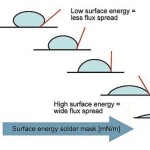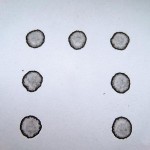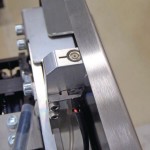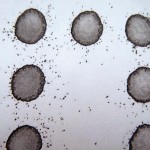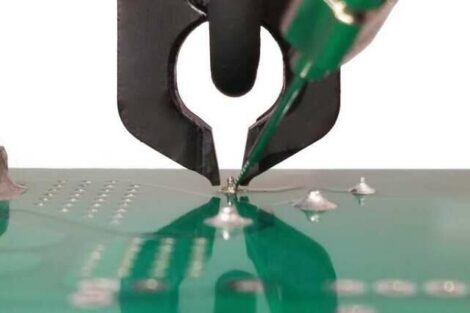Three ingredients are required to make a good solder joint: solder, clean metal surfaces to connect and heat. In a selective soldering process all three have a big influence on the final result. The solder properties define not only the hole filling, but have an impact on the appearance and shininess of the solder joint as well. Heat is required to activate the flux and make the solder flow into the barrels. If there is not enough thermal energy in the assembly the solder will solidify in the barrel during the process and there may not be a sufficient hole fill (defined in the IPC-A-610E chapter 7.3.5).
Gerjan Diepstraten, Vitronics Soltec BV, Oosterhout (The Netherlands)
To improve the hole filling properties and to clean the metal surfaces a flux is applied before the soldering. Critical in this process is that the flux is applied on the right place (cleaning the metal and supporting the solder to penetrate into the barrels) and that the flux is activated. For activation of the flux a specified temperature must be achieved for a certain time. This activation temperature and time are flux specific and should be defined by the flux supplier, since they are the only to be familiar with the ingredients that are used in the flux chemistry.
Flux residues and potential reliability issues
Although the flux has a similar function as in a wave soldering process, selective soldering requires different properties for a flux to be successful. Two of them are essential:
- Spreading. In selective soldering the flux should not spread too far. Flux is only required in the soldering area and should remain there only.
- Inert after soldering. Non-activated flux residues are a potential risk for electro-migration.
Since spreading should be limited it is essential that the mechanism of spreading is well understood. What makes the flux flow into areas where it is not wanted?
Surface energy: The flux spread depends on several factors including:
- Flux surface tension (flux type)
- Surface energy of the board (solder mask)
- Temperature of the flux
- Temperature of the board
For wave soldering a board with a high surface energy (>50mN/m) is preferred. This makes the flux spread to all areas and thus eliminates the risk for open solder joints, bridging, spikes and webbing. Due to the good spreading the residues will be less visible; which is a cosmetic advantage. For selective soldering applications a lower surface energy of the board is wanted. A typical value for a good spreading is ~35mN/m. One should be aware that heating processes before selective soldering (like reflow soldering) may have an effect on the surface energy of the solder mask.
Preheated board
A potential method to minimize flux spreading is preheating the assembly before applying the flux. A small experiment was performed to visualize the impact of a hot surface on the spread. The spreading is good visible on bare copper material. Three fluxes are compared. For this comparison a typical alcohol, a VOC and a VOC-Free water based flux are selected. The amount of flux that was dropped on a copper coupon was 10µl. This was repeated at ambient temperature, and with the coupons at 50ºC and 80ºC preheated. Note the differences:
- An alcohol flux will spread less when the board is preheated, where a VOC-Free water based flux will spread more when the surface is hot.
- Due to the minor spreading the solid content left per cm² is much more for a VOC-Free flux and less for alcohol based.
Since alcohol fluxes are safe the trend for selective soldering fluxes drives into the direction of alcohol based fluxes with a higher solid content to have enough activity per square cm.
Satellite-free dropjet
Dropjet fluxing has become the application method to apply very small amounts of flux very on a very accurate way. Like in inkjet technology during the jetting satellites are formed by nature of the liquid and jetting method. These satellites are very small droplets at the start of the spraying (called head satellites) and at the end when the plunger closes (called tail satellites). Many studies are done using high speed cameras to understand the formation and behaviour of these flux satellites. Since the size and direction are out of control this flux particles may end in unwanted SMD areas and are a potential reliability risk.
Satellite drops, which often follow each fast-moving main drop ejected from the nozzle, are undesirable because they are far more readily misdirected by aerodynamic and electrostatic forces. To eliminate the satellites a new HF (High Frequency) dropjet has been introduced. This device has a sapphire orifice and incorporates an internal pressure compensation bladder. The droplets will retain their integrity longer and travel further.
A way to visualize the flux patterns is fluxing on fax (heat sensitive) paper. To illustrate the satellites and the difference between a HF satellite-free and a common dropjet flux was sprayed on fax paper using the same settings.
Experimental design spreading
To define the spreading of the flux (alcohol based with 3.3% solids) in the mySelective soldering applications a Box-Behnken experiment is selected. In this experiment the three different parameters of the drop-jet flux system are set at two different levels. The parameters are:
- Open time drop-jet (500 – 2500ms)
- Frequency drop-jet (10 – 300Hz)
- Speed of the flux robot (10 – 150mm/s)
Overall the experiment contained 15 runs. The experiment was run on a mySelective 6748 using the traditional dropjet nozzle. The flux was applied on a typical wave soldering board and on a board with a modified solder mask.
In the first column the width of the flux stroke is listed. It is obvious that for the solder mask with a surface energy of 35mN/m (modified for selective soldering) the spreading is better under control. The process window is wider; the width of flux can be varied between 2 and 10 mm with the settings in the experiment. For the board with the higher surface energy the flux spreads up to 16 mm and it is hard to apply a small stroke of flux.
For successful soldering a flux amount between 500 – 2000µg/in2 is required. In the second column the flux amount is calculated (flow measured with a flux flowmeter). Due to the spreading only three settings for the second board are acceptable for soldering, which makes it hard to find the right adjustments for a successful process.
Conclusion of this experiment is that boards designed for wave soldering with a higher surface energy are not suitable for a selective soldering application.
Nitrogen/inert soldering area
As temperatures rise, the flux materials undergo changes in their physical and chemical properties such as the evaporation of volatile fractions, their surface activity, and their melt viscosity. The consequence for the solder flux is early displacement by the scrubbing action of the solder, and ultimately the thermal breakdown of the material. This results in loss of its functionality as a protective blanket, and the loss of an insulating film over the liquid solder when it wicks up the barrel of the via or through-hole.1)
To make selective soldering with a small flux amount successful it is essential that during the soldering the environment is inert. Nitrogen coverage of the solder enables good penetration even with less flux activation. The lack of oxides reduces the bridging and also the solder joints become shinier when there is good nitrogen blanket.
Conclusions
Flux plays a critical rule in the selective soldering process. No matter what technique is used: dip or drag, horizontal or tilted, wettable or non-wettable nozzles. The interaction between flux and solder mask defines the spreading, the amount of dry flux solids per area, and therefore the solder quality. It is better for soldering and reliability to have an alcohol flux with higher solid content that leave more sticky residues than use an organic kind of flux. Invisible flux residues are cosmetic nice, but unprotected activators are a potential risk in the field.
SMT Hybrid Packaging
Booth 9-214
References
- 1.) “Performing Flux-Technology for Pb-Free SN100C Solders”, Apex 2010, Ineke van Tiggelen-Aarden, and Eli Westerlaken, Cobar Europe BV
- 2. ) “How PEDOT:PSS solutions produce satellite-free inkjets”, Stephen D. Hoath, SungjuneJunga, Wen-Kai Hsiaoa and Ian M. Hutchingsa, Department of Engineering, University of Cambridge
ZusAMMENFASSUNG
Um eine gute Lötstelle zu erhalten benötigt man Lot, saubere Metalloberflächen zur Verbindung und Wärme. In einem selektiven Lötverfahren haben alle drei einen großen Einfluss auf das Endergebnis. Die Lot-Eigenschaften definieren nicht nur die Befüllung, sondern haben ebenfalls einen Einfluss auf das Aussehen und den Glanz der Lötstelle. Wärme wird benötigt um das Flussmittel zu aktivieren, damit das Lot fliesst. Fehlt es an thermischer Energie bei der Montage, verfestigt sich das Lot während des Prozesses und es kann zu einer nicht ausreichenden Lötstelle führen.
Afin d’obtenir un bon point de soudure, on abesoin de pâte à souder, de surfaces propres sur le métal pour assurer la connexion et de chaleur. Dans le cadre d’une procédure sélective de soudure, tous ces trois éléments ontune grandeinfluence sur le résultat final. Les caractéristiques de soudure ne définissent pas uniquement le remplissage, mais elles ont également une influence sur l’aspect et le brillant du point de soudure. La chaleur est nécessaire pour activer le produit afin que la soudure coule. S’il manque de l’énergie thermique lors du montage, la soudure se solidifie au cours du processus et cela peut entrainer uneinsuffisance au niveau du point de soudure.
Share:


